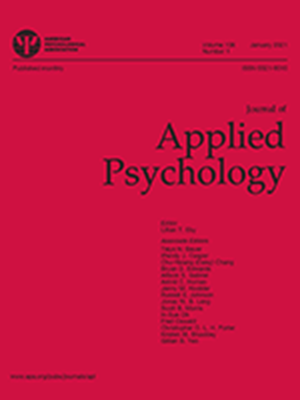基于刺激的团队适应过程模型:综合概念回顾。
IF 9.4
1区 心理学
Q1 MANAGEMENT
引用次数: 0
摘要
由于组织面临着应对不断变化的形势和突发需求的持续压力,团队成员经常需要改变他们的工作流程和常规,适应新的合作方式。在研究适应性时,大多数研究人员都采用行为驱动法,即对团队所面临的多种适应性需求进行折叠,并依靠传统的输入-过程-结果框架(如 Hackman, 1987; McGrath, 1984)来分离出特定的行为反应。然而,这种视角造成了一些重要的局限性。团队要想取得成功,必须对不同类型的适应性刺激做出集体反应,而目前的研究无法解释或区分不同刺激类型和所需反应的适应性需求。在这篇综合概念综述中,我们针对这些局限性,建立了一个新颖的、基于刺激的团队适应阶段模型。我们对新开发的刺激检测、紧迫性识别和持续时间评估阶段的研究,以及团队的适应性反应、适应性表现和经验总结进行了审查。我们整合了适应过程每个阶段的研究,强调了能够证明团队成功适应 "看起来像什么 "的因素,并描述了解决每个阶段关键问题的未来研究途径。(PsycInfo Database Record (c) 2024 APA,保留所有权利)。本文章由计算机程序翻译,如有差异,请以英文原文为准。
A stimulus-based model of the team adaptation process: An integrated conceptual review.
As organizations face constant pressures to respond to changing situations and emergent demands, team members are frequently called upon to change their processes and routines and adapt to new ways of working together. In examining adaptation, most researchers have taken a behavior-driven approach where they collapse across the many types of adaptive demands teams face and rely on traditional input-process-outcome frameworks (e.g., Hackman, 1987; McGrath, 1984) to isolate specific behavioral responses. However, this perspective has resulted in several critical limitations. There are key differences in the way teams must collectively respond to different types of adaptive stimuli to be successful, and current research cannot account for or differentiate adaptive demands by stimulus type and needed responses. In this integrated conceptual review, we address these limitations and develop a novel, stimulus-based phase model of team adaptation. We examine studies across our newly developed stimulus detection, urgency identification, and duration assessment phases, and through the team's adaptive response, adaptive performance, and learning from the experience. We integrate research within each phase of the adaptive process, highlighting factors that demonstrate what successful team adaptation "looks like," and describe future avenues of research to address key issues within each phase. (PsycInfo Database Record (c) 2024 APA, all rights reserved).
求助全文
通过发布文献求助,成功后即可免费获取论文全文。
去求助
来源期刊

Journal of Applied Psychology
Multiple-
CiteScore
17.60
自引率
6.10%
发文量
175
期刊介绍:
The Journal of Applied Psychology® focuses on publishing original investigations that contribute new knowledge and understanding to fields of applied psychology (excluding clinical and applied experimental or human factors, which are better suited for other APA journals). The journal primarily considers empirical and theoretical investigations that enhance understanding of cognitive, motivational, affective, and behavioral psychological phenomena in work and organizational settings. These phenomena can occur at individual, group, organizational, or cultural levels, and in various work settings such as business, education, training, health, service, government, or military institutions. The journal welcomes submissions from both public and private sector organizations, for-profit or nonprofit. It publishes several types of articles, including:
1.Rigorously conducted empirical investigations that expand conceptual understanding (original investigations or meta-analyses).
2.Theory development articles and integrative conceptual reviews that synthesize literature and generate new theories on psychological phenomena to stimulate novel research.
3.Rigorously conducted qualitative research on phenomena that are challenging to capture with quantitative methods or require inductive theory building.
 求助内容:
求助内容: 应助结果提醒方式:
应助结果提醒方式:


